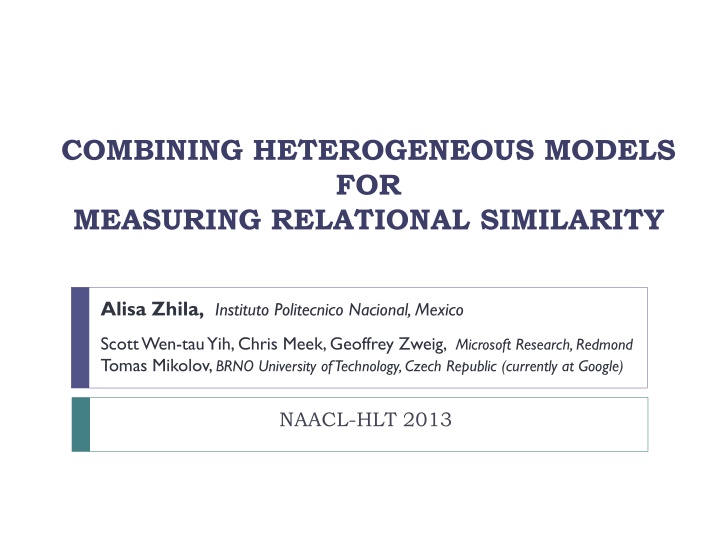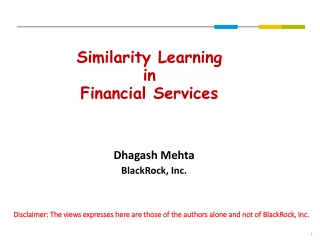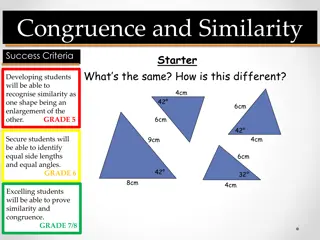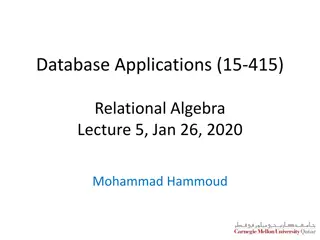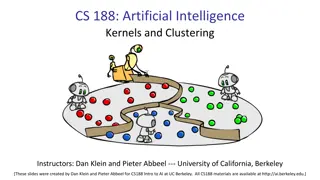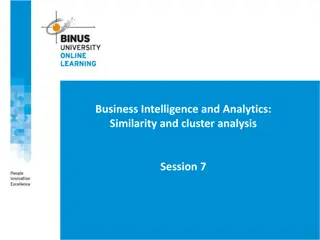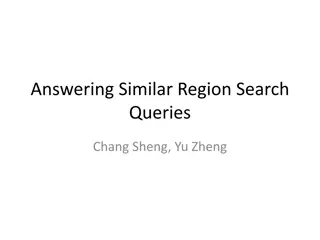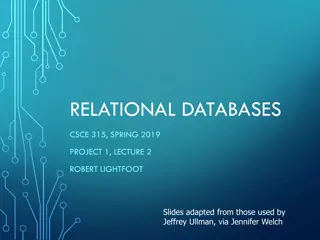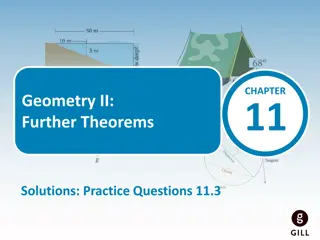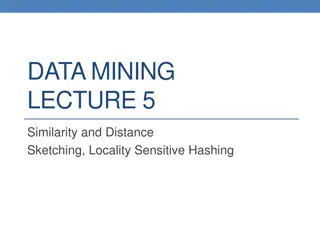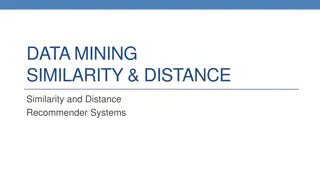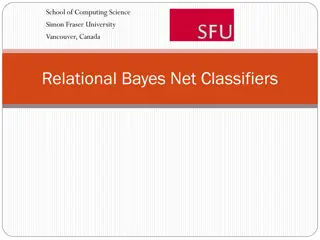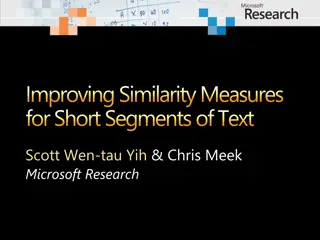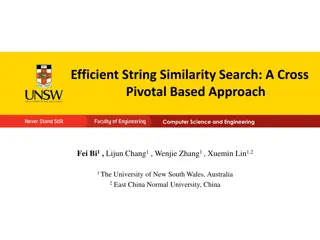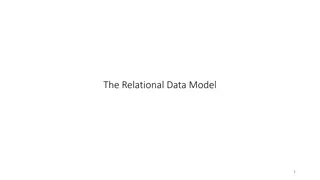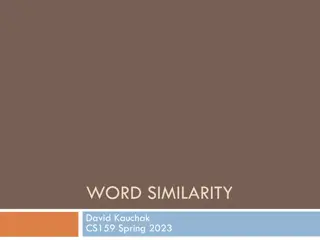Enhancing Relational Similarity Measurements: A Model Combination Approach
This study explores combining heterogeneous models for measuring relational similarity, showcasing the importance of general relational similarity models. It discusses the degrees of relational similarity and introduces a directional similarity model that outperforms previous systems. The approach leverages existing models to achieve better performance, evaluated on SemEval-2012 Task 2 with significant improvement.
Download Presentation

Please find below an Image/Link to download the presentation.
The content on the website is provided AS IS for your information and personal use only. It may not be sold, licensed, or shared on other websites without obtaining consent from the author.If you encounter any issues during the download, it is possible that the publisher has removed the file from their server.
You are allowed to download the files provided on this website for personal or commercial use, subject to the condition that they are used lawfully. All files are the property of their respective owners.
The content on the website is provided AS IS for your information and personal use only. It may not be sold, licensed, or shared on other websites without obtaining consent from the author.
E N D
Presentation Transcript
COMBINING HETEROGENEOUS MODELS FOR MEASURING RELATIONAL SIMILARITY Alisa Zhila,Instituto Politecnico Nacional, Mexico Scott Wen-tau Yih, Chris Meek, Geoffrey Zweig, Microsoft Research, Redmond Tomas Mikolov, BRNO University of Technology, Czech Republic (currently at Google) NAACL-HLT 2013
Introduction: Relations in word pairs Part-of Used In: Relational Search, Product Description wheel : car Synonyms Used In: Word hints, translation car : auto Is-A Used In: Taxonomy population dog : animal 2
Introduction: Relations in word pairs More examples: Cause-effect joke : laughter Time:Associated Itemretirement : pension Mass:Portion water:drop Activity:Stageshopping:buying Object:Typical Action glass:break Sign:Significant siren:danger Many types of various relations!!! Used In: Semantic structure of a document, event detection, word hints 3
Relational Similarity Building a general relational similarity model is a more efficient way to learn a model for any arbitrary relation [Turney, 2008] Prototype pairs: ornithology:birds, psychology:mind, astronomy:stars, ballistics:projectile Target pairs: herpetologist:salamander, school:students Relation type: Knowledge 4
Degrees of relational similarity Is-A relation mammal: primate mammal: whale mammal: porpoise ENTITY:SOUND dog : bark car : vroom cat : meow Binary decision on a relation loses these shades. 5
Problem Given a few prototypical pairs: mammal: whale, mammal:porpoise Determine which target pairs express the same relation: mammal: primate, mammal: dolphin, astronomy:stars And to what degree: Prob[word pairi relation Rj] 6
Contributions Introduced Directional Similarity model Core method for measuring of relation similarity degrees Outperform the previous best system Exploited advantages of existing relation similarity models by combining heterogeneous models Achieved even better performance Evaluated on SemEval-2012 Task 2: Measuring Degrees of Relational Similarity Up to 54% improvement over previous best result 7
Outline Introduction Heterogeneous Relational Similarity Models General Relational Similarity Models Relation-Specific Models Combining Heterogeneous Models Experiment and Results Conclusions and Future Work 8
General Models: Directional Similarity Model 1/2 Prototype pair: clothing : shirt Target pair: furniture : desk Directional Similarity Model is a variant of Vector Offset Model [Tomas Mikolov et al., 2013 @ NAACL] Language Model learnt through Recurrent Neural Network, RNNLM Vector Space in RNNLM 9
General Models: Directional Similarity Model 2/2 Prototype pair: clothing : shirt Target pair: furniture : desk Words are represented as vectors in RNNLM shirt desk clothing furniture Relational Similarity via Cosine between word pair vectors 10
General Models: Lexical Pattern Model [E.g. Rink and Harabagiu, 2012] Extract lexical patterns: Word pairs (mammal : whale), (library : books) Corpora: Wikipedia, GigaWord Lexical patterns: word sequences encountered between given words of a word pair mammals such as whales , library comprised of books Hundreds of thousands of lexical patterns collected Features: log(pattern occurrence count) Train a log-linear classifier: Positive and negative examples for a relation 11
Relation Specific Models: Knowledge Bases Relation-specific information from Knowledge Bases Probase [Wu et al., 2012] > 2.5M concepts Relations between large part of the concepts Numerical Probabilities for relations For (furniture : desk) gives Prob[(furniture : desk) Relation Rj] We considered relations: Is-A weapon:knife, medicine:aspirin Attribute glass:fragile, beggar:poor 12
Relation Specific Models: Lexical Semantics Measures Polarity-Inducing Latent Semantic Analysis, PILSA [Yih et al. 2012] Distinguishes between Synonyms and Antonyms Vector Space model Words represented as unit vectors Words with opposite meanings correspond to oppositely directed vectors Degree of synonymy/antonymy measured as cosine burning hot cold freezing 13
Combining Heterogeneous Models Learn an optimal linear combination of models Features: outputs of the models Logistic regression: regularizers L1 and L2 selected empirically Learning settings: Positive examples: ornithology:birds, psychology:mind, astronomy:stars, ballistics:projectile Negative examples: school:students, furniture:desk, mammal:primate Learns a model for each relation/prototype pair group 14
Outline Introduction Heterogeneous Relational Similarity Models Experiment and Results Task & Dataset Results Analysis of combined models Conclusions and Future Work 15
Task & Dataset 1/2 SemEval 2012 Task 2: Measuring Degrees of Relational Similarity 3-4 prototype pairs for 79 relations in 10 main categories: Class Inclusion, Attribute, Case Relations, Space-Time 40 example pairs in a relation Not all examples represent the relation equally well an X indicates/signifies Y " siren:danger " "signature:approval " "yellow:caution" Gold Standard Rankings of example word pairs per relation ranked by degrees of relational similarity based on inquiries of human annotators 16
Task & Dataset 2/2 Task: automatically rank example pairs in a group and evaluate against the Gold Standard Evaluation metric: Spearman rank correlation coefficient How well an automatic ranking of pairs correlates with the gold standard one by human annotators Settings: 10 relations in a development set with known gold standard rankings 69 relations in a testing set 17
Approaches to Measuring Relational Similarity Degree Duluth systems [Pedersen, 2012] Word vectors based on WordNet + cosine similarity BUAP system [Tovar et al., 2012] Word pair represented in a vector space + Cosine between target pair and a prototypical example UTD systems [Rink and Harabagiu, 2012] Lexical patterns between words in a word pair + Na ve Bayes Classifier or SVM classifier Some systems were able to outperform the random baseline, yet there was still much room for improvement 18
Results: Averaged Performance Spearman's 0.350 0.300 54.1 % improvement 0.250 0.200 0.150 0.100 0.050 0.000 Co-HM 1 2 3 4 5 19
Results: Per Relation Group Relation Groups 1 CLASS INCLUSION 2 PART -WHOLE 3 SIMILAR 4 CONTRAST 5 ATTRIBUTE 6 NON-ATTRIBUTE 7 CASE RELATION 8 CAUSE-PURPOSE 9 SPACE-TIME 10 REFERENCE UTD-NB Co-HM 9 winning cases out of 10 20
Analysis: Model Ablation Study From a combined model take out each individual model one by one: -Is-A -Attribute -DS -PILSA -Patterns -DS shows substantial drop in performance: 33% drop in Spearman s (0.353 0.238 ) Ablation of other models does not show statistically significant change in result However, combining all the models together gives great improvement compared to DS model only 9% increase in Spearman s (0.324 0.353) 21
Outline Introduction Heterogeneous Relational Similarity Models Experiment and Results Conclusions and Future Work 22
Conclusions & Future Work State-of-the-art results Introduced Directional Similarity model A general model for measuring relational similarity for arbitrary relations Introduced combination of heterogeneous general and relation-specific models for even better relational similarity measuring In the future: How to choose individual models for specific relations? User study for relation similarity ceiling Compare various VSM (RNNLM vs. others) Thank you! 23
